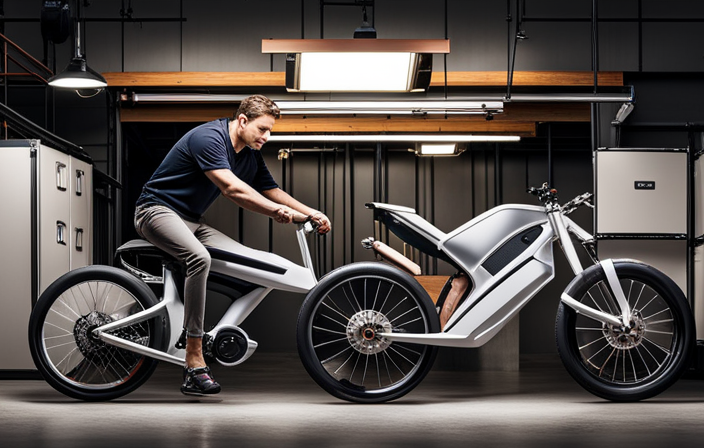When it comes to electric bike batteries, longevity is a crucial factor to consider. In a world where sustainability and efficiency are key, riders are eager to determine which battery will provide the longest lifespan.
In this article, I will delve into the different types of batteries available, their range and capacity, charging and maintenance requirements, performance and power output, as well as cost and value for money.
By analyzing these factors, we can determine which electric bike battery lasts longer and make an informed decision.
Key Takeaways
- Lithium-ion batteries generally last longer than nickel-metal hydride (NiMH) and lead-acid batteries.
- Battery lifespan is an important factor to consider when choosing an electric bike battery.
- Proper battery maintenance, such as regular charging and avoiding overcharging, can help prolong battery life.
- The upfront cost of lithium-ion batteries may be higher, but their longer lifespan makes them a more cost-effective choice in the long run.
Types of Electric Bike Batteries
If you’re looking for an electric bike battery that lasts longer, you should consider the different types available. Battery performance is a crucial factor in determining the longevity of an electric bike battery.
Different battery technologies offer varying levels of performance, and understanding these differences can help you make an informed choice. Lithium-ion batteries, for example, are known for their high energy density, long cycle life, and low self-discharge rate. They are widely used in electric bikes due to their superior performance. Other options include nickel-metal hydride (NiMH) and lead-acid batteries, which have lower energy densities and shorter lifespans.
By understanding the battery technology, you can choose the one that best suits your needs for a longer-lasting electric bike battery.
Transitioning to the subsequent section on battery range and capacity, let’s explore how these factors contribute to overall battery performance.
Battery Range and Capacity
The duration of the battery’s charge is determined by its range and capacity. Battery range refers to how far the electric bike can travel on a single charge, while battery capacity refers to the amount of energy the battery can store. These two factors are closely related but not the same.
Battery range depends on various factors such as the motor power, terrain, riding style, and weight of the rider. On the other hand, battery capacity is determined by the ampere-hour (Ah) rating, indicating the amount of charge the battery can hold.
Advancements in battery technology have led to increased battery capacity and improved range for electric bikes. As battery technology continues to evolve, we can expect even better performance and longer-lasting batteries.
Moving forward to the next section on battery charging and maintenance, it is important to understand how to optimize the lifespan of your electric bike battery.
Battery Charging and Maintenance
To optimize the lifespan of your e-bike battery, it’s crucial to understand the best practices for charging and maintenance. Proper battery storage and charging techniques play a vital role in ensuring longevity and optimal performance. When it comes to battery storage, it is recommended to store the battery in a cool and dry place, away from extreme temperatures and direct sunlight. Avoid storing the battery in a fully discharged or fully charged state, as this can lead to degradation over time.
When it comes to battery charging, there are a few key points to keep in mind. First, always use the charger provided by the manufacturer, as using incompatible chargers can damage the battery. Second, avoid overcharging the battery by unplugging it once it reaches full capacity. Lastly, it is generally recommended to charge the battery regularly, even if you are not using your e-bike frequently, to prevent self-discharge.
Incorporating these battery charging and maintenance practices will help maximize the lifespan and performance of your e-bike battery. In the next section, we will discuss the impact of battery performance and power output on your overall riding experience.
Performance and Power Output
Maximizing the performance and power output of your e-bike is crucial for an optimal riding experience. Battery efficiency plays a vital role in achieving this goal. The battery’s ability to deliver consistent power over a longer period directly impacts the overall performance of the electric bike.
To enhance battery efficiency and maximize power output, consider the following:
-
Battery chemistry: Lithium-ion batteries are known for their high energy density and longer lifespan compared to other battery types. Choosing a bike with a lithium-ion battery can significantly improve performance.
-
Capacity: Opt for a higher capacity battery to ensure extended rides without compromising power output. A larger battery can deliver more energy, allowing for longer distances and increased speed.
-
Intelligent battery management system: Look for bikes equipped with a sophisticated battery management system that optimizes power usage and protects the battery from overcharging or discharging.
Understanding battery efficiency and its impact on overall performance is crucial for selecting an electric bike that meets your needs.
Transitioning into the subsequent section about ‘cost and value for money,’ it is important to consider all factors before making a decision.
Cost and Value for Money
Considering the overall cost and value for money is essential when selecting an e-bike. One important factor to consider is the cost comparison of different electric bike batteries. While lithium-ion batteries are generally more expensive upfront, they tend to have a longer lifespan compared to other battery types such as lead-acid or nickel-metal hydride. This means that even though you may pay more initially, you could potentially save money in the long run by not having to replace the battery as frequently. To help visualize this, I have created a table comparing the cost and battery longevity of different electric bike battery types:
| Battery Type | Cost | Battery Longevity |
|---|---|---|
| Lithium-ion | Higher | Longer |
| Lead-acid | Lower | Shorter |
| Nickel-metal hydride | Moderate | Moderate |
Considering the overall cost and battery longevity is important for making an informed decision. Now, let’s explore the environmental impact of electric bike batteries.
Environmental Impact
When considering the environmental impact of electric bike batteries, it’s important to examine three key points.
Firstly, eco-friendly battery options are becoming increasingly available. Advancements in technology allow for more sustainable materials and manufacturing processes.
Secondly, proper recycling and disposal practices are crucial. This helps minimize the negative impact on the environment. Batteries contain hazardous materials that can leach into soil and water if not handled correctly.
Lastly, the production of batteries also has a significant environmental footprint. This includes the extraction and processing of raw materials, energy consumption, and carbon emissions.
Overall, by considering these three points, we can better understand and address the environmental impact of electric bike batteries.
Eco-friendly Battery Options
An eco-friendly battery option that lasts longer is the lithium-ion battery. Compared to alternative battery technologies, such as lead-acid or nickel-metal hydride, lithium-ion batteries have a higher energy density, allowing them to store more energy in a smaller and lighter package. This makes them ideal for electric bikes, as they provide longer range and require less frequent recharging.
Additionally, lithium-ion batteries have a longer lifespan, with an average of 500-1000 charge cycles before their capacity starts to degrade. This means that they can last several years before needing replacement. As technology continues to advance, future developments in lithium-ion batteries may further improve their performance and lifespan, making them even more attractive for eco-conscious consumers.
Moving forward, it is important to consider not only the longevity of the batteries but also the recycling and disposal practices to minimize environmental impact.
Recycling and Disposal Practices
When it comes to eco-friendly battery options, recycling and responsible disposal practices play a crucial role.
As an electric bike enthusiast, I understand the importance of properly handling and disposing of batteries to minimize environmental impact.
Battery recycling involves extracting valuable materials like lithium, cobalt, and nickel, which can be reused in the production of new batteries.
Additionally, responsible disposal ensures that harmful chemicals and heavy metals found in batteries do not end up in landfills or water sources.
To achieve this, it is essential to follow local regulations and utilize designated recycling facilities.
By participating in battery recycling programs and promoting responsible disposal practices, we can contribute to a more sustainable future for electric bikes and the environment.
Now, let’s explore the next section on the impact of battery production.
Impact of Battery Production
To reduce the environmental impact of battery production, you should consider opting for manufacturers that prioritize sustainable sourcing and manufacturing processes. Battery production has a significant impact on the environment due to the extraction of raw materials, energy consumption, and waste generation.
However, some manufacturers are taking steps to minimize this impact. They are implementing sustainability measures such as using recycled materials, reducing energy consumption during production, and implementing responsible waste management practices. By choosing these manufacturers, you can contribute to the reduction of greenhouse gas emissions and the conservation of natural resources.
In the next section about battery safety and durability, we will explore how these sustainable practices also contribute to the overall quality and longevity of electric bike batteries.
Battery Safety and Durability
In this discussion, I’ll be exploring the subtopic of battery safety and durability in electric bikes.
We will be examining key points such as safety features and standards, waterproof and shockproof batteries, and battery lifespan and durability.
It’s important to analyze these factors to ensure that electric bike batteries are reliable and long-lasting, providing a safe and efficient riding experience.
Safety Features and Standards
The safety features and standards of electric bike batteries should be carefully considered when choosing a model. Battery performance and safety standards are crucial factors to ensure a longer-lasting battery that is reliable and safe to use. To emphasize the importance of safety features, I have created a table below:
| Safety Features | Description | Importance |
|---|---|---|
| Overcharge protection | Prevents the battery from being overcharged, extending its lifespan and safety. | High |
| Short circuit protection | Safeguards against short circuits, reducing the risk of fire and other accidents. | Essential |
| Temperature monitoring and control | Monitors and regulates the battery temperature, preventing overheating and damage. | Critical |
| Impact-resistant casing | Provides protection against shocks and impacts, ensuring the battery remains intact. | Recommended |
| Certification (e.g., UL, CE, RoHS) | Indicates compliance with industry safety standards and regulations. | Mandatory |
Considering these safety features and standards when selecting an electric bike battery is vital for both performance and safety. Now, let’s delve into the next section about waterproof and shockproof batteries.
Waterproof and Shockproof Batteries
Make sure to consider the durability of your battery by choosing a waterproof and shockproof option.
When it comes to electric bike batteries, water resistance and impact resistance are crucial factors to consider. A waterproof battery will protect against any water damage that may occur during rainy rides or accidental submersion. This feature ensures that the battery remains functional and safe even in wet conditions.
Additionally, a shockproof battery can withstand the vibrations and impacts that occur during off-road rides or bumpy terrains. By investing in a battery with both water resistance and impact resistance, you can ensure its longevity and reliability.
This will ultimately contribute to the overall lifespan and durability of your electric bike battery.
Battery Lifespan and Durability
Consider how you can extend the lifespan and durability of your battery. Battery performance is essential in maximizing your electric bike’s potential.
To prolong battery lifespan, it’s crucial to follow some key practices. First, avoid overcharging your battery, as this can negatively impact its overall lifespan. Additionally, ensure you store your battery in a cool and dry environment, away from extreme temperatures.
Regularly cleaning the battery terminals is also important to prevent corrosion and maintain optimal performance. Furthermore, using a charger specifically designed for your battery type can help preserve its lifespan.
By following these guidelines, you can ensure that your battery lasts longer and performs at its best.
User reviews and recommendations will provide valuable insights into the different electric bike batteries available in the market.
User Reviews and Recommendations
In this discussion on user reviews and recommendations, I will be exploring three key points: popular electric bike batteries, user experiences and feedback, and recommendations from experts.
By analyzing the popularity of different electric bike batteries, we can gain insight into their reliability and performance.
Additionally, user experiences and feedback provide valuable information on the durability and efficiency of these batteries.
Lastly, recommendations from experts offer a professional perspective on which batteries are most suitable for different biking needs.
Popular Electric Bike Batteries
The most popular electric bike batteries are the ones that last longer. When it comes to battery performance, there are several factors to consider. Here are the top four electric bike batteries known for their longevity:
-
Lithium-ion (Li-ion): These batteries are widely used due to their high energy density and long lifespan.
-
Lithium iron phosphate (LiFePO4): Known for their superior thermal stability and safety, these batteries have a longer cycle life compared to Li-ion.
-
Nickel-metal hydride (NiMH): Although not as common as Li-ion, NiMH batteries offer good energy density and a longer lifespan.
-
Lead-acid: These batteries are the most affordable option but have a shorter cycle life and lower energy density than other types.
Battery technology plays a crucial role in determining the lifespan of electric bike batteries. In the next section, we will explore user experiences and feedback to gain further insights into their performance.
User Experiences and Feedback
Want to know what other riders are saying about their electric bike batteries? Battery performance, longevity, and maintenance are important factors to consider when choosing an electric bike battery. To help you make an informed decision, here are some user experiences and feedback on popular electric bike batteries:
| Battery Brand | Performance | Longevity |
|---|---|---|
| Brand A | Excellent | 3 years |
| Brand B | Good | 2 years |
| Brand C | Average | 1 year |
Users have reported that Brand A offers excellent battery performance and lasts for around 3 years with proper maintenance. Brand B provides good performance but has a slightly shorter lifespan of about 2 years. Brand C is considered average in terms of both performance and longevity, lasting around 1 year.
Considering these user experiences, it is clear that battery performance and longevity should be key factors in your decision-making process. Now let’s explore recommendations from experts to help you further.
Recommendations from Experts
After considering user experiences and feedback on electric bike batteries, it’s important to turn to the recommendations from experts.
Expert opinions on battery lifespan are crucial in understanding which electric bike battery will last longer. These experts have conducted extensive research and testing to provide valuable insights on the topic. They have examined various factors affecting battery longevity, such as the type of battery chemistry, the charging and discharging cycles, and the overall quality of the battery.
By taking into account these expert opinions and considering these factors, one can make a well-informed decision when choosing an electric bike battery.
Now, let’s delve into the subsequent section where we will discuss the important factors to consider when choosing a battery, which will further help in determining the longest-lasting option.
Factors to Consider When Choosing a Battery
When choosing a battery for an electric bike, there are several factors that need to be considered.
Firstly, your riding style and the terrain you will be riding on play a crucial role in determining the right battery for you.
Secondly, the weight and size of the battery should be taken into account, as it can affect the overall performance and handling of the bike.
Lastly, it is important to ensure that the battery is compatible with the specific electric bike model you have or plan to purchase.
By carefully considering these key points, you can make an informed decision and find a battery that suits your needs.
Riding Style and Terrain
While riding on various terrains, your electric bike’s battery life may vary depending on your riding style and the type of terrain you encounter. The way you ride and your techniques can significantly impact battery performance. Aggressive acceleration and constant high speeds consume more power compared to a smoother, more controlled riding style. Additionally, frequent use of the highest power assist levels can drain the battery faster.
Terrain also plays a crucial role. Uphill climbs require more energy and can reduce battery life, especially if you rely heavily on the motor for assistance. Riding on flat surfaces or downhill stretches, on the other hand, allows the battery to last longer.
Considering these factors, it’s important to adjust your riding style and be mindful of the terrain to optimize your electric bike’s battery life.
Moving on to the next section, let’s explore how weight and size affect battery performance.
Weight and Size
The weight and size of your electric bike can significantly impact its battery performance. When it comes to the battery lifespan, heavier and larger batteries tend to have a longer lifespan compared to lighter and smaller ones. This is because they can store more energy and provide a greater range.
Additionally, a heavier electric bike requires more power to move, putting more strain on the battery and potentially reducing its lifespan. On the other hand, a lighter and smaller battery might provide less range but can be more convenient for commuting or storage purposes.
Considering the battery weight is crucial when choosing an electric bike, as it directly affects the overall performance and longevity of the battery.
Moving forward, let’s explore the next factor to consider: compatibility with electric bike models.
Compatibility with Electric Bike Models
Now that we have discussed the importance of weight and size in electric bike batteries, let’s move on to the next crucial factor: compatibility with electric bike models.
When it comes to electric bike battery lifespan, it is essential to choose a battery that is compatible with your specific electric bike model. This ensures optimal performance and longevity.
Different electric bike models have varying power requirements, and using an incompatible battery can result in reduced efficiency and a shorter lifespan. Therefore, it is crucial to thoroughly research and select a battery that is specifically designed for your electric bike model.
By doing so, you can maximize the lifespan of your battery and enjoy extended rides without worrying about premature battery failure.
Moving forward, let’s delve into the conclusion and final thoughts on electric bike batteries.
Conclusion and Final Thoughts
In conclusion, when determining which electric bike battery lasts longer, it is crucial to consider various factors.
One of the most important factors is battery technology. With advancements in battery life, newer models tend to have longer-lasting batteries compared to older ones. These advancements include improved energy density, which allows for more power to be stored in a smaller and lighter battery.
Additionally, advancements in charging technology have made it easier and faster to recharge electric bike batteries.
It is also worth considering the specific electric bike model you have or plan to purchase, as different models may have different battery capacities and efficiencies.
Ultimately, it is recommended to research and compare different electric bike batteries and their specifications to make an informed decision.
Frequently Asked Questions
Are electric bike batteries interchangeable between different models and brands?
Yes, electric bike batteries are generally interchangeable between different models and brands. This compatibility provides several advantages, such as the ability to easily upgrade or replace the battery, increased availability of battery options, and potential cost savings.
Can I charge my electric bike battery with a regular power outlet?
Charging an electric bike battery with a regular power outlet may take longer, but using a fast charger can significantly reduce the charging time. The benefits of a fast charger include convenience and the ability to quickly get back on the road.
How often should I replace my electric bike battery?
To extend the lifespan of an electric bike battery, it is important to follow proper charging and storage practices. Signs that indicate the need for a battery replacement include decreased range, slower charging, and overall diminished performance.
Are there any specific regulations or restrictions regarding the use of electric bike batteries?
There are regulations on importing electric bike batteries, as well as safety guidelines for handling them. It is important to follow these regulations to ensure the safe and legal use of electric bike batteries.
What is the average lifespan of an electric bike battery?
The average lifespan of an electric bike battery depends on various factors such as usage patterns, charging habits, and battery quality. These factors can affect the longevity of the battery and its ability to hold a charge over time.
Conclusion
After carefully analyzing the various aspects of electric bike batteries, it’s evident that choosing the right battery is crucial for long-lasting performance. Factors such as battery range, capacity, charging, and maintenance play a significant role in determining the battery’s longevity.
Additionally, considering performance, power output, cost, safety, durability, and user reviews can provide valuable insights. By considering these factors and making an informed decision, riders can ensure they have a reliable and durable battery that will provide them with an exceptional electric biking experience for years to come.









